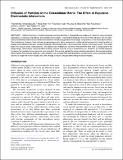Diffusion of Particles in the Extracellular Matrix: The Effect of Repulsive Electrostatic Interactions
Author(s)
Stylianopoulos, Triantafyllos; Poh, Ming-Zher; Insin, Numpon; Bawendi, Moungi G.; Fukumura, Dai; Munn, Lance L.; Jain, Rakesh K.; ... Show more Show less
DownloadStylianopoulos-2010-Diffusion of Particl.pdf (871.5Kb)
PUBLISHER_POLICY
Publisher Policy
Article is made available in accordance with the publisher's policy and may be subject to US copyright law. Please refer to the publisher's site for terms of use.
Terms of use
Metadata
Show full item recordAbstract
Diffusive transport of macromolecules and nanoparticles in charged fibrous media is of interest in many biological applications, including drug delivery and separation processes. Experimental findings have shown that diffusion can be significantly hindered by electrostatic interactions between the diffusing particle and charged components of the extracellular matrix. The implications, however, have not been analyzed rigorously. Here, we present a mathematical framework to study the effect of charge on the diffusive transport of macromolecules and nanoparticles in the extracellular matrix of biological tissues. The model takes into account steric, hydrodynamic, and electrostatic interactions. We show that when the fiber size is comparable to the Debye length, electrostatic forces between the fibers and the particles result in slowed diffusion. However, as the fiber diameter increases the repulsive forces become less important. Our results explain the experimental observations that neutral particles diffuse faster than charged particles. Taken together, we conclude that optimal particles for delivery to tumors should be initially cationic to target the tumor vessels and then change to neutral charge after exiting the blood vessels.
Date issued
2010-09Department
Harvard University--MIT Division of Health Sciences and Technology; Massachusetts Institute of Technology. Department of ChemistryJournal
Biophysical Journal
Publisher
Elsevier
Citation
Stylianopoulos, Triantafyllos, Ming-Zher Poh, Numpon Insin, Moungi G. Bawendi, Dai Fukumura, Lance L. Munn, and Rakesh K. Jain. “Diffusion of Particles in the Extracellular Matrix: The Effect of Repulsive Electrostatic Interactions.” Biophysical Journal 99, no. 5 (September 2010): 1342–1349. © 2010 Biophysical Society.
Version: Final published version
ISSN
00063495
1542-0086